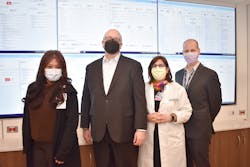Leaders at Mount Sinai Morningside, an urban community hospital in New York City, sought to design a command center to manage both emergency incidents and daily operations. Although the command center was not originally intended to address pandemic issues, the hospitals’ information network has provided its leaders with real-time data for efficient and effective decision making in the current environment.
A team came together to review the current information reports that were available to leaders and managers and a gap analysis exercise that focused on what information was needed to manage and what information was missing. The team chose to include data into the new information system based on new attributes including real-time accessibility, definable targets, and ability to trigger standard work or action. The team then worked together with their information technology colleagues and pulled the new data points from their electronic health record (EHR) and simply used 10 television screens to display the information, which updates every four to five minutes. The completed project was dubbed the Daily Management and Incident Command Center (DMC).
The electronic dashboards are used to drive the conversations in the organization’s daily multidisciplinary safety huddle and seamlessly allow sharing of information with the DMC. One main use of the displayed information is to manage patient flow by continually reviewing bed capacity and demand. In the team’s daily huddle, they intentionally talk about cross-connections across the traditional silos of healthcare delivery. For instance, the impact of delayed inpatient discharges is clearly linked to the number of admitted patients boarding in the Emergency Department. Radiology and transport turn-around times are clearly linked to timing of discharges. This exercise of daily collaboration and multidisciplinary review of information fosters teamwork between the various hospital services and was instrumental in building the capability to rapidly respond to the fast-changing challenge presented by the pandemic. The product was originally created to manage daily operations and to respond to incidents such as weather emergencies and mass casualties but became an invaluable asset to the COVID Incident Management team. The information framework allows staff to rapidly surge and pivot with confidence, knowing that the right information is in the right place at the right time to be operationalized by the right people.
In the near future, leaders Mount Sinai Morningside say they plan to hone the deployment of operational resources by incorporating predictive analytics into the information framework of the DMC.
A joke sparks innovation
Healthcare Innovation spoke with the core team for the DMC at the organization, who saw the value before the project even began. “Prior to the creation of the Daily Management Center and Incident Command Center, when we would have an incident that we would have to manage, it was sort of a running joke about where we should set up incident command,” Arthur Gianelli, president and chief transformation officer, says. “Like it was a quick flurry of activity to find what we needed to find and to set up in temporary space and we were sort of the butt of [the health] system’s joke about needing an incident command center. Eventually, we got to thinking, let's figure out if we can combine what we want to do on the Epic side and pull out operational data in real time to be able to make decisions and then also leverage that information to help us to manage incidents. That's how those two concepts came together. Then, we worked with our partners who really took our vision and were able to operationalize it and were able to give the team a lot of the details that were necessary to populate the tiles in the command center.”
Lucy Xenophon, M.D., chief transformation officer, adds that “We had a problem with patients staying too long in the hospital, what we call a long length of stay. Art and I were discussing it one day and he said, ‘Well, why don't we just make it discharge command center?’ And so that's what we did. We didn't have Epic at the time, and we literally were tracking patient milestones using construction paper and magnets and dry erase boards. Just around that same time we found out that we would be getting Epic and we were also looking for space for the incident piece of the command center.”
Xenophon then tells the story of when they approached their IT team, on one hot summer day. She notes that she brought lemonade to sweeten the deal. “And with this very crazy idea, they agreed,” Xenophon comments. “We started on the journey using lean by bringing together all the potential stakeholders that we could think of and asked them, ‘Can you bring us the reports that you use every day to manage your work?’ And they did. We literally hung them up in the ‘lean lab’ and it took up three out of the four walls. We whittled and curated until we came up with the data we really need. And our IT colleagues were amazing translators, because saying something clinically and doing something IT wise often requires a translator.”
As to who was part of the multidisciplinary team, Xenophon says, “We had a meeting that included supervisors and managers from clinical teams, nursing, social work case management support teams transport, radiology, environmental services, the admitting team, and infectious disease emergency department. We had every possible stakeholder that we could think of that would have input into running our business. We were very aware, being a Lean hospital, that one of the major things we were trying to accomplish was to breakdown the silos of care and so getting everyone in the same room at the same time to really think about what is it that we actually need. And then building a command center where we could literally ping around the room to make those connections and connect the dots for people was a goal and we started to accomplish that goal by the initial bringing together of all those stakeholders.”
Thinking outside the box leads to success for the team
As with any project of this size, there were challenges. Brian Radbill, M.D., chief medical officer and senior vice president for medical affairs, says that “We definitely had a strong vision of how we saw the command center and I think that a part of the challenge was a little bit of a push and pull and compromise.”
He adds that there were “definitely things that were out of the box” that the team wanted and that if everyone had agreed to use what was prebuilt it would have been a disservice to the project overall because the end result really had to be very personal and hospital/department specific.
Of course, there are also significant wins for the and the system as a whole. Lagrimas Fausto, senior director of the DMC, brought up an example. She says, “An HVAC system went down in one of the other hospitals in the system, so they immediately called me. And my first questions to them were, what type of building and what type of patients are in that building that you need to move or possibly transfer? They said psychiatry, and I said, ‘two seconds.’ I turned around, read what I saw on the screen, and gave them [the information].”
Analytics are only months away
Regarding analytics in the near future, Paul Francaviglia, senior director, IT, comments, “For predicting capacity and throughput, we have two models under development with that team, and those are going through trials now. I would say it's probably on the order of weeks to months before we have that capacity in place. One of the challenges is additional data sources. For example, nursing, staffing data and how that might be a strong predictor in that model and where that source of truth is how we can incorporate that data. We certainly have the pathway.”
As to what’s next, Gianelli says that “We definitely want to begin to bring in predictive analytics in a strong way. There's a lot of work going on right now in perfecting the algorithms and that's the right work to occur, but I think when we're ready, we really want to pull it in because my goal from an operational standpoint is to start to move toward operating the hospital on the basis of the information that are predictive algorithms start to give us so that.”


